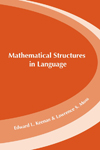Edward L. Keenan and Lawrence S. Moss
Mathematical Structures in Language introduces a number of mathematical
concepts that are of interest to the working linguist. The areas covered include
basic set theory and logic, formal languages and automata, trees, partial
orders, lattices, Boolean structure, generalized quantifier theory, and linguistic
invariants, the last drawing on Edward L. Keenan and Edward Stabler's
Bare Grammar: A Study of Language Invariants, also published by CSLI Publications.
Ideal for advanced undergraduate and graduate students of linguistics,
this book contains numerous exercises and will be a valuable resource
for courses on mathematical topics in linguistics. The product of many years
of teaching, Mathematical Structures in Language is very much a book to be
read and learned from.
Edward L. Keenan is professor of linguistics at the University of California, Los Angeles. Lawrence S. Moss is professor of mathematics at Indiana University, Bloomington.
- Preface
- 1 The Roots of Infinity
- 1.1 The Roots of Infinity in Natural Language
- 1.2 Boolean Compounding
- 1.3 References
- 2 Some Mathematical Background
- 2.1 More about Sets
- 2.2 Sequences
- 2.3 Functions and Sequences
- 2.4 Arbitrary Unions and Intersections
- 2.5 Definitions by Closure (Recursion)
- 2.6 Bijections and the Sizes of Cross Products
- 2.7 A Linguistic Function
- 2.8 A Closing Reflection on Functions
- 2.9 Suggestions for Further Study
- 2.10 Addendum 1: Russell's Paradox
- 2.11 Addendum 2: An Equivalent, Useful, Definition of Closure
- 2.12 Addendum 3: Some Initial Hints on Setting up Proofs
- 3 Boolean Phonology
- 3.1 Abstract Segmental Phonology
- 3.2 Enriching Feature Sets
- 3.3 Some Phonological Generalizations
- 3.4 TheMathematical Structure of Feature Sets
- 3.5 Significant Sound Segments
- 4 Syntax I: Trees and Order Relations
- 4.1 Trees
- 4.2 C-Command
- 4.3 Sameness of Structure: Isomorphism
- 4.4 Labeled Trees
- 4.5 Ordered Trees
- 4.6 Concluding Formal Exercises on Relations and Ordered Trees
- 5 Syntax II: Design for a Language
- 5.1 Beginning Grammar
- 5.2 Eng– Towards a Grammar of English
- 5.3 Word Order Variation in Other Languages
- 5.4 Three New Types of DPs
- 6 A Taste of Formal Language Theory
- 6.1 Introduction
- 6.2 CFGs: A Formal Definition
- 6.3 How Well Do CFGs Model Natural Languages?
- 7 Finite State Automata
- 7.1 Finite-State Automata
- 7.2 Regular Expressions and Languages
- 7.3 Simple Grammars
- 7.4 Closing the Circle
- 7.5 anbn is not a Regular Language
- 7.6 An ArgumentWhy English is Not Regular
- 7.7 Two Final Observations on Finite State Automata
- 8 Semantics I: Compositionality and Sentential Logic
- 8.1 Compositionality and Natural Language Semantics
- 8.2 Sentential Logic
- 8.3 Interpreting a Fragment of English
- 9 Semantics II: Coordination, Negation and Lattices
- 9.1 Coordination: Syntax
- 9.2 Coordination: Semantics
- 9.3 Negation and Additional Properties of Natural Language Lattices
- 9.4 Properties versus Sets: Lattice Isomorphisms
- 9.5 Theorems on Boolean Lattices
- 9.6 Some (Possibly) Unexpected Boolean Lattices
- 9.7 A Concluding Note on Point of View
- 9.8 Further Reading
- 9.9 Appendix: Tarski-Knaster and Schröder-Bernstein
- 10 Semantics III: Logic and Variable Binding Operators
- 10.1 Translation Semantics
- 10.2 Some General Linguistic Properties of First Order Logic (FOL)
- 10.3 Extending the Class of VBO's: The Lambda Operator
- 11 Semantics IV: DPs, Monotonicity and Semantic Generalizations
- 11.1 Negative Polarity Items
- 11.2 Monotonicity
- 11.3 Semantic Generalizations
- 11.4 Historical Background
- 12 Semantics V: Classifying Quantifiers
- 12.1 Quantifier Types
- 12.2 Generalizations Concerning Det Denotations
- 12.3 k-Place Dets
- 12.4 Crossing the Frege Boundary
- 12.5 A Classic Syntactic Problem
- 12.6 Adverbial Quantification
- 12.7 Concluding Remarks
- 12.8 Historical Background
- 12.9 Appendix: Some Types of English Determiners
- 13 Linguistic Invariants
- 13.1 A Model Grammar and Some Basic Theorems
- 13.2 A Semantic Definition of Anaphor
- 13.3 A Model of Korean
- 13.4 Toba Batak
- 13.5 Some Mathematical Properties of Grammars and their Invariants
- 13.6 Invariants of Type 0
- 13.7 Invariants of Type (1)
- 13.8 Invariants of Type (2) and Higher
- 13.9 Structure Preserving Operations on Grammars
- List of Symbols
- Bibliography
- Author Index
- Language Index
- Subject Index
September 29, 2016


